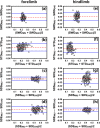Four-limb wireless IMU sensor system for automatic gait detection in canines
- PMID: 35314731
- PMCID: PMC8938443
- DOI: 10.1038/s41598-022-08676-1
Four-limb wireless IMU sensor system for automatic gait detection in canines
Abstract
This study aims to develop a 4-limb canine gait analysis system using wireless inertial measurement units (IMUs). 3D printed sensor holders were designed to ensure quick and consistent sensor mounting. Signal analysis algorithms were developed to automatically determine the timing of swing start and end in a stride. To evaluate the accuracy of the new system, a synchronized study was conducted in which stride parameters in four dogs were measured simultaneously using the 4-limb IMU system and a pressure-sensor based walkway gait system. The results showed that stride parameters measured in both systems were highly correlated. Bland-Altman analyses revealed a nominal mean measurement bias between the two systems in both forelimbs and hindlimbs. Overall, the disagreement between the two systems was less than 10% of the mean value in over 92% of the data points acquired from forelimbs. The same performance was observed in hindlimbs except for one parameter due to small mean values. We demonstrated that this 4-limb system could successfully visualize the overall gait types and identify rapid gait changes in dogs. This method provides an effective, low-cost tool for gait studies in veterinary applications or in translational studies using dog models of neuromuscular diseases.
© 2022. The Author(s).
Conflict of interest statement
DD is a member of the scientific advisory board for Solid Biosciences and equity holders of Solid Biosciences. The Duan lab received research supports unrelated to this project from Solid Biosciences. The Duan lab has received research supports unrelated to this project from Edgewise Therapeutics. Other authors declare no competing interests.
Figures






References
Publication types
MeSH terms
Grants and funding
LinkOut - more resources
Full Text Sources

